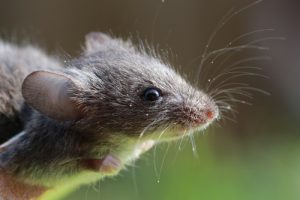Mice: Q & A #2
By Chris Williams on November 9, 2010.
Q. Can mice really travel along electrical lines to get inside a building? I’m worried that mice might be following our lines and getting into the attic.
A. It’s very possible for mice to walk lines or cables and enter your attic around the opening where the lines enter the building if that opening has not been caulked or sealed. Mice have extraordinary physical abilities. They can climb and run along pipes, cables, and electrical lines. They can even travel for considerable distances upside down.
Mice can also reach attic openings by simply climbing up an outside wall. They can run up almost any vertical surface if it is rough like brick or concrete. They can even climb up downspouts and vinyl or aluminum siding by using their small, sharp toes to hang on to edges and corner folds. Mice can also get onto roofs by following branches from trees or shrubs or ivy that touch the roof.
 Once near the roof line, mice can usually find lots of small openings that will allow them access to the attic or other roof void. Their small body size allows them to squeeze through a slot-like opening that is little more than 1/4-inch high. You can see why mouse-proofing your home to eliminate entry points for mice is important. We can help. Call Colonial and ask about our mouse-proofing services.
Once near the roof line, mice can usually find lots of small openings that will allow them access to the attic or other roof void. Their small body size allows them to squeeze through a slot-like opening that is little more than 1/4-inch high. You can see why mouse-proofing your home to eliminate entry points for mice is important. We can help. Call Colonial and ask about our mouse-proofing services.
So, you think you have mice in your attic? Here are some mouse signs to look for:
- Mouse droppings. A single mouse can deposit 70 droppings a day as it travels about. Droppings are dark and 1/8 to 1/4-inch in length.
- Mouse odor. Mice, especially in large numbers, produce a very distinctive musky odor.
- Nests. Mouse nests are small piles of soft materials like shredded paper, insulation material, string, chewed leaves, etc. You may find hoarded food (like stolen pet food or bird seed) near mouse nests.
- Gnawing. Mice chew a lot, on most anything. They will chew the edges of an opening to make it larger. They’ve also been known to chew on electrical wires in attics, causing fires.
- Noises. You may hear lots of scatching or scrambling noises in the attic but noises could be from squirrels or other animals as well.
- Rub marks. Creatures of habit, mice travel the same routes all the time. The oils in their fur leave dark, greasy smudge marks where they brush against walls or objects.
- Footrpints. In dusty locations, you may see mouse footprints or tail drag marks.
Call Colonial Pest Control. We can conduct a thorough inspection for mice, and if necessary, design a mouse control program specific to your needs. We are experts in rodent removal, mice control, and we can even mouse-proof your home. Have mice? Call us.